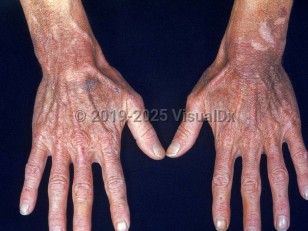Pellagra
Alerts and Notices
Important News & Links
Synopsis

Pellagra is found worldwide but is more common in developing countries where poverty and malnutrition are more common (in part because the staple grains are not fortified with niacin). In addition to the skin, the neurologic system and gastrointestinal system are involved. Skin eruption tends to be photodistributed, symmetric, and erythematous. It may be accompanied by pain or itch. Various neurologic and gastrointestinal complaints such as dizziness, tremors, insomnia, fatigue, mood symptoms, nausea, vomiting, and diarrhea can be present and may precede skin manifestations.
The most common etiologies of pellagra are alcohol use disorder, various medications, inadequate intake, and malabsorption. Risk factors include poverty, staple diet that is poor in niacin (maize, Indian millet, or jowar), eating disorders, human immunodeficiency virus (HIV), alcohol abuse, medication (isoniazid, pyrazinamide, carbamazepine, carbidopa, chloramphenicol, phenytoin, phenobarbital), chemotherapy (5-fluorouracil, 6-mercaptopurine, azathioprine), post-surgical complications (gastrectomy), carcinoid syndrome (tryptophan is converted to serotonin instead of niacin), malabsorptive states (eg, Crohn disease, Hartnup disease), and hypothyroidism.
Symptoms of niacin or tryptophan deficiency take months to develop due to large tissue stores. Death due to multiorgan failure will occur in 4-5 years if left untreated.
Codes
E52 – Niacin deficiency [pellagra]
SNOMEDCT:
418186002 – Pellagra
Look For
Subscription Required
Diagnostic Pearls
Subscription Required
Differential Diagnosis & Pitfalls

Subscription Required
Best Tests
Subscription Required
Management Pearls
Subscription Required
Therapy
Subscription Required
Drug Reaction Data
Subscription Required
References
Subscription Required

